By Jeanne Neath
“My friends, do we realize for what purpose we are convened? Do we fully understand that we aim at nothing less than an entire subversion of the present order of society, a dissolution of the whole existing social compact.”
(Elizabeth Oakes Smith, September 8 1852, 3rd National Women’s Rights Convention)
 Millions of women have worked over centuries for the “subversion of the present order of society, a dissolution of the whole existing social compact.” We have wrought vast changes to women’s situation in many parts of the world. Yet now the decades long right wing driven backlash has been joined by runaway misogyny on the Internet and in the real world, as well as “transgender” males trying to take on and take over the identity of “woman.” Transactivists want to define real women out of existence and make it impossible for women to meet in public in groups that exclude males. With the misogynist support of many of the Left, transactivists are fighting to end the revolution of women. Women now face backlash from the right and Left!
Millions of women have worked over centuries for the “subversion of the present order of society, a dissolution of the whole existing social compact.” We have wrought vast changes to women’s situation in many parts of the world. Yet now the decades long right wing driven backlash has been joined by runaway misogyny on the Internet and in the real world, as well as “transgender” males trying to take on and take over the identity of “woman.” Transactivists want to define real women out of existence and make it impossible for women to meet in public in groups that exclude males. With the misogynist support of many of the Left, transactivists are fighting to end the revolution of women. Women now face backlash from the right and Left!
How unsurprising that women and the movement for Women’s Liberation should be under such strong assault right at the moment in time when the fate of an entire civilization is twisting in the wind. You know the list of evils that have shaped the world we are living in – from patriarchy and capitalism, to racism and colonialism and on and on. The immediate repercussions for us are growing at exponential speed – from police assaults in Black communities, to the COVID-19 pandemic, to pipeline and other land grabs on indigenous and public lands, to anti-immigration atrocities, to the loss of jobs and homes in a nosediving economy, to climate chaos bringing us record-setting wildfires, floods, and more.
How unsurprising that women and the movement for Women’s Liberation should be under such strong assault right at the moment in time when the fate of an entire civilization is twisting in the wind.
Perhaps the men (mostly white) in power could have continued their exploitation of other humans indefinitely, but their exploitation of the Earth has irrevocable consequences. This civilization faces an ultimatum from the Earth and will either undergo a paradigm shift and end its practices of domination and exploitation or crumble under the pressures of climate chaos and other ecological failures.
Eco-Disaster! Scientists Call for Society’s Basic Structures to Change
 After reading a recent report about the global state of the natural world, the word “necrophilia” began to haunt me. Defined by Mary Daly as the “hatred for and envy of Life,” Daly considered necrophilia to be the “most fundamental characteristic of patriarchy.” (Wickedary, p. 83 or online) The report, the “Global Assessment Report on Biodiversity and Ecosystem Services: Summary for Policymakers,” was released in 2019 by IPBES, a U.N. international panel of 150 experts who, with the help of another 350 scientists, reviewed 15,000 publications on the state of nature. (IPBES stands for the Intergovernmental Science-Policy Platform on Biodiversity and Ecosystem Services.)
After reading a recent report about the global state of the natural world, the word “necrophilia” began to haunt me. Defined by Mary Daly as the “hatred for and envy of Life,” Daly considered necrophilia to be the “most fundamental characteristic of patriarchy.” (Wickedary, p. 83 or online) The report, the “Global Assessment Report on Biodiversity and Ecosystem Services: Summary for Policymakers,” was released in 2019 by IPBES, a U.N. international panel of 150 experts who, with the help of another 350 scientists, reviewed 15,000 publications on the state of nature. (IPBES stands for the Intergovernmental Science-Policy Platform on Biodiversity and Ecosystem Services.)
A kind of scientific horror story, the report details the destruction of Life. We learn, for example, that globally, “natural ecosystems have declined by 47 per cent on average, relative to their earliest estimated states” and “the global biomass of wild mammals has fallen by 82 per cent.” (p. 25) If patriarchal hatred and envy of life is not at play, it is certainly difficult to understand how we have come to create this Sixth Extinction of life on earth.
Climate change is the ecological disaster we hear the most about, but IPBES found that the two “direct drivers of change in nature with the largest global impact” were humans 1) taking over land and sea (through agriculture, building infrastructure and expanding urban areas) and 2) direct exploitation of “animals, plants and other organisms, mainly via harvesting, logging, hunting and fishing.” (p. 12) The climate crisis was the third ranked destroyer of nature, though its impacts will inevitably increase. (See cropped Figure SPM 2 below, from the IPBES report.)
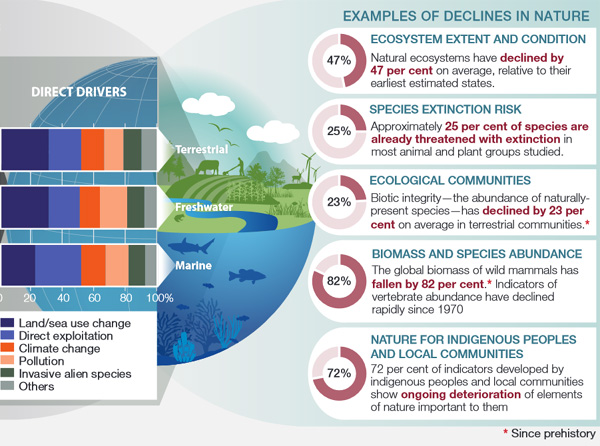
What surprised me most was that these 150 experts recognized that the only way out of this ecological crisis is “transformative” and “structural” change to the economy and society: “Goals for conserving and sustainably using nature and achieving sustainability cannot be met by current trajectories, and goals for 2030 and beyond may only be achieved through transformative changes across economic, social, political and technological factors.” (p. 14) The authors explain what they mean by “transformative”: “A fundamental, system-wide reorganization across technological, economic and social factors, including paradigms, goals and values.” (p. 14, IPBES report’s footnote 4) They continue: “Since current structures often inhibit sustainable development and actually represent the indirect drivers of biodiversity loss, such fundamental, structural change is called for.” (p. 16, italics above are mine)
What surprised me most was that these 150 experts recognized that the only way out of this ecological crisis is “transformative” and “structural” change to the economy and society.
You can be sure that the IPBES authors did not call for structural change without an overwhelming reason to do so. They made projections for the earth’s and humanity’s future by considering three scenarios. The earth fared better in the global sustainability scenario (proactive environmental policy, low consumption and low carbon emissions) than in the economic optimism (rapid growth, low environmental regulation) and regional competition scenarios. In all three scenarios almost all regions of the world did have an increase in nature’s “material contributions to people” (providing food, feed, timber, bioenergy).
But, all three scenarios, including even the “global sustainability” scenario, proved to be deadly for humans and the natural world. Both biodiversity and the ability of nature to provide “ecosystem services” essential to human societies spiraled downward. (See p. 38, IPBES report, Figure SPM 8 for comparisons of the three scenarios for different regions of the world.) Don’t let your eyes glaze over at mention of the term “ecosystem services.” Yes, this is a very human-centric way of looking at Earth’s activities, but these “services,” including crop pollination, crop pest control, natural carbon storage, and protecting the soil from erosion and loss of carbon and nitrogen, are critical to human survival.
Even the “global sustainability” scenario proved to be deadly for humans and the natural world. Both biodiversity and the ability of nature to provide “ecosystem services” essential to human societies spiraled downward.
The important point here is that IPBES is calling for a paradigm change as this is the only way to keep ecosystems functioning well enough to support human life and curtail the Sixth Extinction of life on earth.
Patriarchal Civilization in Crisis: The Paradigm Must Shift
Nafeez Ahmed, a perceptive male journalist, speaks bluntly about the IPBES report: “The report concludes that human civilization is systematically destroying its own life-support systems…” He continues: “The report is by far the most comprehensive to hit home how the collapse of biodiversity ultimately entails the collapse of human civilization.”
Ahmed points out that civilizational collapse is already underway: “Our democracies are in a state of collapse: incapable of addressing the systemic complexity of the crisis of civilization.” What is this systemic complexity? There are the climate and ecological crises we’ve been talking about. Then there is the question of how society can do away with the unending growth and exploitation that drives these crises when its worldviews, value systems, political and economic structures are deeply based in a paradigm of domination and profit-taking. The problems become impossibly complex as ecological and climate disruptions spawn social problems like wars and conflicts, large scale human migrations, and losses in communities wracked by wildfires and floods. As Ahmed explains, “our political leaders are preoccupied with the surface symptoms of this fundamental crisis of civilization rather then the crisis itself.”
“Our democracies are in a state of collapse: incapable of addressing the systemic complexity of the crisis of civilization.”
Ahmed argues that even the most forceful non-violent resistance cannot force fundamental changes on a system that is incapable of handling the extent and complexity of change required: “To break this paradigm requires far more than making demands of broken institutions.” He says that a paradigm shift must overturn the very basis of society, from the economic system to people’s deeply held values and beliefs to how we relate to others and live our everyday lives. Ahmed believes this paradigm shift can be brought on by individuals taking responsibility for changing ourselves, asking “how can I actually mobilize to build the new paradigm,” and taking “radical action in our own place-based contexts to build the seeds of the new paradigm, right here, right now.”
And Now…Sisterhood of Women and Earth
I don’t think the IPBES, Nafeez Ahmed, or the vast majority of radicals from the Left are looking for a women’s revolution when they call for paradigm change. It has become very clear with its pandering to the transgender movement that the Left is very willing to toss women and Lesbians under the bus. Any shift in paradigm that is not driven primarily by women would keep patriarchy in place and we know what that would mean for the Earth and for women.
As I see it, we must go further than what Ahmed suggests. Any new paradigm must move out of patriarchy and be based in Female and Earth centered societies. The tasks for women will depend on our what society or societies we are part of. We may be deeply embedded in the dominant society (globalized capitalist patriarchy) or belong, primarily or to a lesser extent, to Indigenous or other societies outside the dominant society.
Existing Matriarchal and Indigenous societies are already living in the new/old paradigm, yet women within them struggle against incursions by the dominant society and, in some societies, with a degree of male domination within. (Male domination within Indigenous societies is often the result of past and present colonization by invading patriarchal societies, but can also derive from “ancestral original patriarchy.”[1])
Women trapped within the dominant society can learn from Indigenous and Matriarchal societies and provide support for those cultures and the women in those cultures, as it is requested. Additional key tasks for women ensconced in the dominant society are to work to stop that society and all its oppressive practices and begin actively creating new Female and Earth centered systems and societies to replace the dominant global patriarchy.
Earth, the most powerful female force, is speaking clearly with every raging wildfire, hellish hurricane, or seething flood tearing at this man-made civilization. Nothing less than an equally fiery movement of women can turn the paradigm that is patriarchy into ashes.
The movement for Women’s Liberation lacks power now, thanks to decades of backlash and the divisions amongst us. The continued belief of many women in reform has always hobbled the movement, but now many reform-minded feminists are supporting transactivists and actively turning against radical feminists. The transactivists’ attempts to erase women and Lesbians and their campaign to label radical feminists as “TERFs” and cancel us are proving to be both an obstacle for Women’s Liberation as well as a consciousness raiser that draws more and more women to radical feminism.
In order to build up the international Women’s Liberation movement we must step up our organizing against queer and transgender ideologies and end the Left’s love affair with transactivism. We must stop the runaway misogyny. At the same time, our focus on a decolonizing ecofeminism, the power of our female bodies and spirits, the wisdom of women from every race and culture, and the creation of new – and defense of existing – Female and Earth centered subcultures, cultures, and societies serves as inspiration and refuge, as well as helping create the needed shift in paradigm. As women’s movement and power builds and ecological understandings come to the fore, support for transgender attempts to use excessive medical (Earth) resources and disregard biological realities will fade.
The Earth herself is now demanding “nothing less than an entire subversion of the present order of society,” the goal of women in 1852 and the goal of radical feminists today. Earth, the most powerful female force, is speaking clearly with every raging wildfire, hellish hurricane, or seething flood tearing at this man-made civilization. Nothing less than an equally fiery movement of women can turn the paradigm that is patriarchy into ashes. Yes, time is short as Earth’s temperature rises, but women are rising too. With the sisterhood of women and Earth teamed up against it, I don’t think capitalist patriarchy stands a chance. As Susan B. Anthony told us, “Failure is Impossible!”
Footnotes
1. Here’s a quote from Betty Ruth Lozano Lerma: “Latin American feminisms question both Western patriarchy and the subordination of non-heterosexual women and persons within indigenous and Afro-descendant cultures. They affirm the existence of pre-Hispanic patriarchies, giving rise to concepts such as ‘ancestral original patriarchy’ and ‘low-intensity patriarchy,’ which show how women within the colonial context experienced an entanglement of patriarchies –entronque de patriarcados and, for the Afro-descendant case, ‘a black-colonial patriarchy’…” In “Latin American and Caribbean Feminisms” by Betty Ruth Lozano Lerma, an article in Pluriverse: A Post-Development Dictionary.

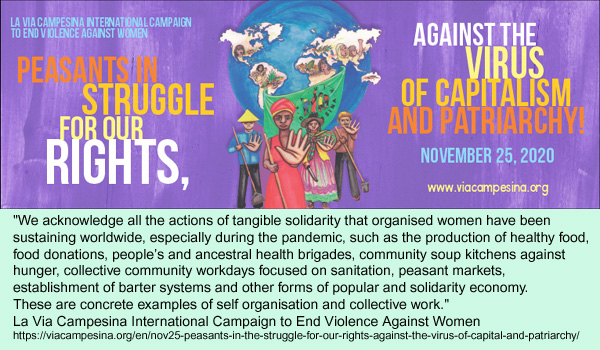

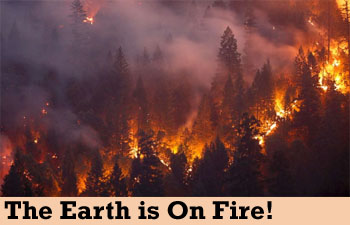 We are standing up against the powerful people and corporations determined to maintain the deadly and profitable status quo.
We are standing up against the powerful people and corporations determined to maintain the deadly and profitable status quo. In her book,
In her book,  After all these many decades, feminists continue to struggle, as social divisions have proved incredibly difficult to bridge in societies rooted in privilege and division. Creating justice for all within the powerful global network of social movements envisioned by Naomi Klein and within the myriad of global societies is, perhaps, a task for a truly desperate people. Yet, desperate is what we are with the Earth at high risk.
After all these many decades, feminists continue to struggle, as social divisions have proved incredibly difficult to bridge in societies rooted in privilege and division. Creating justice for all within the powerful global network of social movements envisioned by Naomi Klein and within the myriad of global societies is, perhaps, a task for a truly desperate people. Yet, desperate is what we are with the Earth at high risk. Transactivists verbally attack women (and anyone else) who disagrees with transideology with screams of “TERF” (i.e. Trans Exclusionary Radical Feminist). At times, these attacks include
Transactivists verbally attack women (and anyone else) who disagrees with transideology with screams of “TERF” (i.e. Trans Exclusionary Radical Feminist). At times, these attacks include  If males can be women (or female!), then being a woman loses any meaning other than being a person who complies with female sex stereotypes (and that leaves out many females who refuse to comply with those stereotypes). The transgender self-id laws currently being considered or passed in some states and countries essentially allow anyone who wants to say they are a woman to legally become a woman (and female).
If males can be women (or female!), then being a woman loses any meaning other than being a person who complies with female sex stereotypes (and that leaves out many females who refuse to comply with those stereotypes). The transgender self-id laws currently being considered or passed in some states and countries essentially allow anyone who wants to say they are a woman to legally become a woman (and female). 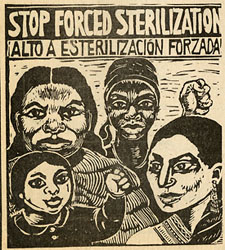 This is why abortion laws are highly contested, why contraception is under fire, why some societies are sterilizing women of color against their will. And much more.
This is why abortion laws are highly contested, why contraception is under fire, why some societies are sterilizing women of color against their will. And much more.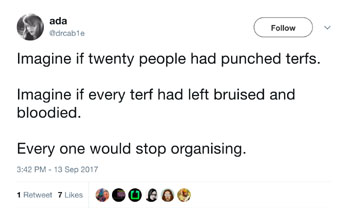 How are women to maintain our own liberation movement, let alone be powerful participants in coalitions to break the power of the forces destroying the earth? The social-economic system that is creating ecological disaster and human misery is primarily a product of the male imagination because that system has always been heavily male dominated. This system is not going to be undone without the contributions of radical feminists, the women who are specialists in understanding patriarchy. The use of the slur, “TERF,” against radical feminists is an assault against every resistance fighter and against the Earth since a broad resistance cannot succeed without radical feminism. Women’s hands must be untied if the resistance is to be successful.
How are women to maintain our own liberation movement, let alone be powerful participants in coalitions to break the power of the forces destroying the earth? The social-economic system that is creating ecological disaster and human misery is primarily a product of the male imagination because that system has always been heavily male dominated. This system is not going to be undone without the contributions of radical feminists, the women who are specialists in understanding patriarchy. The use of the slur, “TERF,” against radical feminists is an assault against every resistance fighter and against the Earth since a broad resistance cannot succeed without radical feminism. Women’s hands must be untied if the resistance is to be successful. 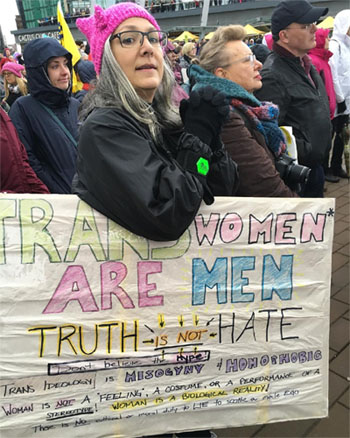 How will women get the justice we deserve with a rogue minority group at our throats and a misogynist Left helping transactivists tear into us? Klein is correct that we all need justice and that we all are needed in the fight to stop the capitalist, colonialist patriarchy destroying the planet. This need for justice includes transgender people, of course. Every feminist I know supports transgender people’s right to live free of violence, free from discrimination in jobs and housing, and free to act in any masculine or feminine way they want.
How will women get the justice we deserve with a rogue minority group at our throats and a misogynist Left helping transactivists tear into us? Klein is correct that we all need justice and that we all are needed in the fight to stop the capitalist, colonialist patriarchy destroying the planet. This need for justice includes transgender people, of course. Every feminist I know supports transgender people’s right to live free of violence, free from discrimination in jobs and housing, and free to act in any masculine or feminine way they want.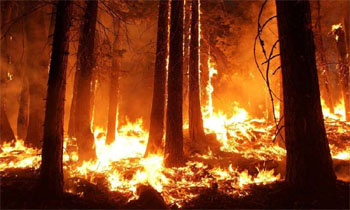 The feminist movement and a movement of transgender people embracing their transgender identity (and not grabbing anyone else’s identity) would have many concerns in common, especially with undoing harms caused by patriarchy and sex role stereotypes. Women and transgender people could be natural allies, just as gay men could be allies to Lesbians. But, these alliances require everyone under the GBTQ umbrella to drop their misogyny and focus on dismantling patriarchy (along with capitalism, racism, colonialism…). Women could certainly use the help in getting the entire network of resistance movements working with us to end patriarchy. The assaults on the Earth come from patriarchal social systems and patriarchy must be undone if we are to avert ecological disaster.
The feminist movement and a movement of transgender people embracing their transgender identity (and not grabbing anyone else’s identity) would have many concerns in common, especially with undoing harms caused by patriarchy and sex role stereotypes. Women and transgender people could be natural allies, just as gay men could be allies to Lesbians. But, these alliances require everyone under the GBTQ umbrella to drop their misogyny and focus on dismantling patriarchy (along with capitalism, racism, colonialism…). Women could certainly use the help in getting the entire network of resistance movements working with us to end patriarchy. The assaults on the Earth come from patriarchal social systems and patriarchy must be undone if we are to avert ecological disaster.